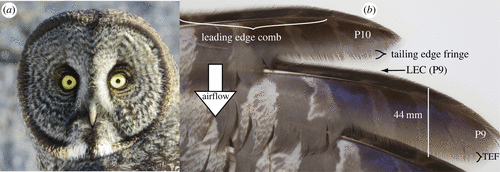グレーの捕食者は視覚ではなく、音に頼っている Great gray predators rely on sound, not sight
2022-11-30 カリフォルニア大学リバーサイド校(UCR)
フクロウが餌を見つけるためにレーダーのように使っている、円盤状の広い顔に関連する重要な発見があった。フクロウの耳の肉付きの良い部分は、フクロウの顔の特徴と同じように機能している。フクロウの羽の下にある開口部から、顔の中央付近にある耳に向かって音が流れる。
大きな顔面円盤は低周波音に敏感に反応する。鳥類の中で最も大きな顔面円盤を持つカラフトフクロウは、好物のハタネズミを狩るために作られた。
雪がハタネズミの鳴き声に与える影響を調べるため、フクロウが狩りをするときに作る穴の横に穴を掘った。その穴の中にスピーカーを設置し、高周波のホワイトノイズや低周波のハタネズミの鳴き声を録音して、さまざまな音を再生した。
6つの深さの雪山から聞こえてくる音を、複数のマイクで構成された音響カメラで撮影した。解析の結果、低周波の音が最もよく伝わることがわかった。3キロヘルツ以下の音だけが20インチの厚さの雪の層を通過し、高い周波数の音はすべて消えてしまった。
真上から音が伝わる距離が短くなり、その場所から音が伝わる雪の量も少なくなる。これはフクロウが必要な場所に着陸するのに確実に役立つ。
また、ハタネズミの鳴き声に集中できるよう、飛行音を弱める翼を備えているようだ。この種はフクロウの中で最も飛行音が静かで、長いフリンジ状の翼は厚いビロードで覆われている。この翼が持つ消音効果は、狩りのホバリング時に特に有効であると考えられる。
<関連情報>
- https://news.ucr.edu/articles/2022/11/30/how-giant-faced-owls-snag-voles-hidden-snow
- https://royalsocietypublishing.org/doi/10.1098/rspb.2022.1164
雪の下でハタネズミを狩るカラフトフクロウは、音響蜃気楼を打ち消すようにホバリングしている Great Gray Owls hunting voles under snow hover to defeat an acoustic mirage
Christopher J. Clark,James Duncan and Robert Dougherty
Proceedings of the Royal Society B Published:23 November 2022
DOI:https://doi.org/10.1098/rspb.2022.1164

Abstract
How do Great Gray Owls (Strix nebulosa) capture voles (Cricetidae) through a layer of snow? As snow is a visual barrier, the owls locate voles by ear alone. To test how snow absorbs and refracts vole sound, we inserted a loudspeaker under the snowpack and analysed sound from the loudspeaker, first buried, then unburied. Snow attenuation coefficients rose with frequency (0.3 dB cm-1 at 500 Hz, 0.6 dB cm-1 at 3 kHz) such that low-frequency sound transmitted best. The Great Gray Owl has the largest facial disc of any owl, suggesting they are adapted to use this low-frequency sound. We used an acoustic camera to spatially localize sound source location, and show that snow also refracts prey sounds (refractive index: 1.16). To an owl not directly above the prey, this refraction creates an ‘acoustic mirage’: prey acoustic position is offset from its actual location. Their hunting strategy defeats this mirage because they hover directly over prey, which is the listening position with least refraction and least attenuation. Among all birds, the Great Gray Owl has the most extreme wing morphologies associated with quiet flight. These extreme wing traits may function to reduce the sounds of hovering, with implications for bioinspiration.



